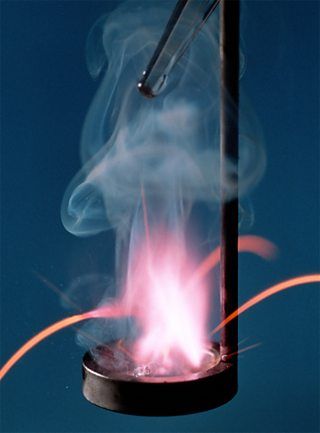Reaction of Group I Elements with Oxygen
Group I consist of alkali metals and these are very reactive. They rapidly react with oxygen so they should be stored out of contact with oxygen to prevent the oxidation process. By moving down the group reactivity is increased. The less reactive metals such as sodium potassium and lithium are stored in the oil to prevent the reaction of oxidation.
Cesium and the rubidium are typically stored in the sealed glass tubes to eliminate the risk of their contact with the air. They are stored in the inert gas or a vacuum and the tubes should be broken open to using the metals. A different type of oxide is formed when the metal is burned and it depends on the period of the metal. The reactions of metal with air and oxygen are the same but more violent reaction is observed with the oxygen.

When lithium is burned in the air it produces the strong red-tinged flame. If it is burned in the pure oxygen then the flame is much more intense. Its reaction with the oxygen gives the lithium oxide.
Small pieces of sodium burn in the air and give a faint orange glow. When a larger amount of sodium is burnt then it produces the strong flame of orange color. In this reaction, a mixture of sodium peroxide and sodium oxide is produced.
When small pieces of potassium are heated in the air then it is melted and is instantly converted into the mixture of the potassium superoxide and potassium peroxide and the flame is not visible.
Ignition of cesium and rubidium in the air produces their superoxides. The superoxides of both are described as yellow or orange but the color of rubidium superoxide can be dark brown as well.
The reaction of Group II Elements with Oxygen
To find the trend of reactions of metals with oxygen is almost impossible. It cannot be said that by moving down the group these metals burn more vigorously. As a whole, metals when burns with the oxygen form a simple metal oxide. Beryllium is reluctant to burn unless in the form of powder or dust. On its surface, it has a strong layer of beryllium oxide that prevents the new oxygen to get in.
When magnesium is burnt in the air it gives a typical and intense white flame.
Calcium does not start burning easily but later on it dramatically bursts into the flame and gives intense white flame and at the end produces the tinge of red color.
Just like calcium strontium is also reluctant to start burning but when it burns it gives the intense white flame followed by the red tinges outside the flame and produces the strontium peroxide.
When barium is burnt a flame of pale green color is produced. The flame appears to be white in color with the pale green tinges. It is not anymore dramatically noticeable than the magnesium flame.